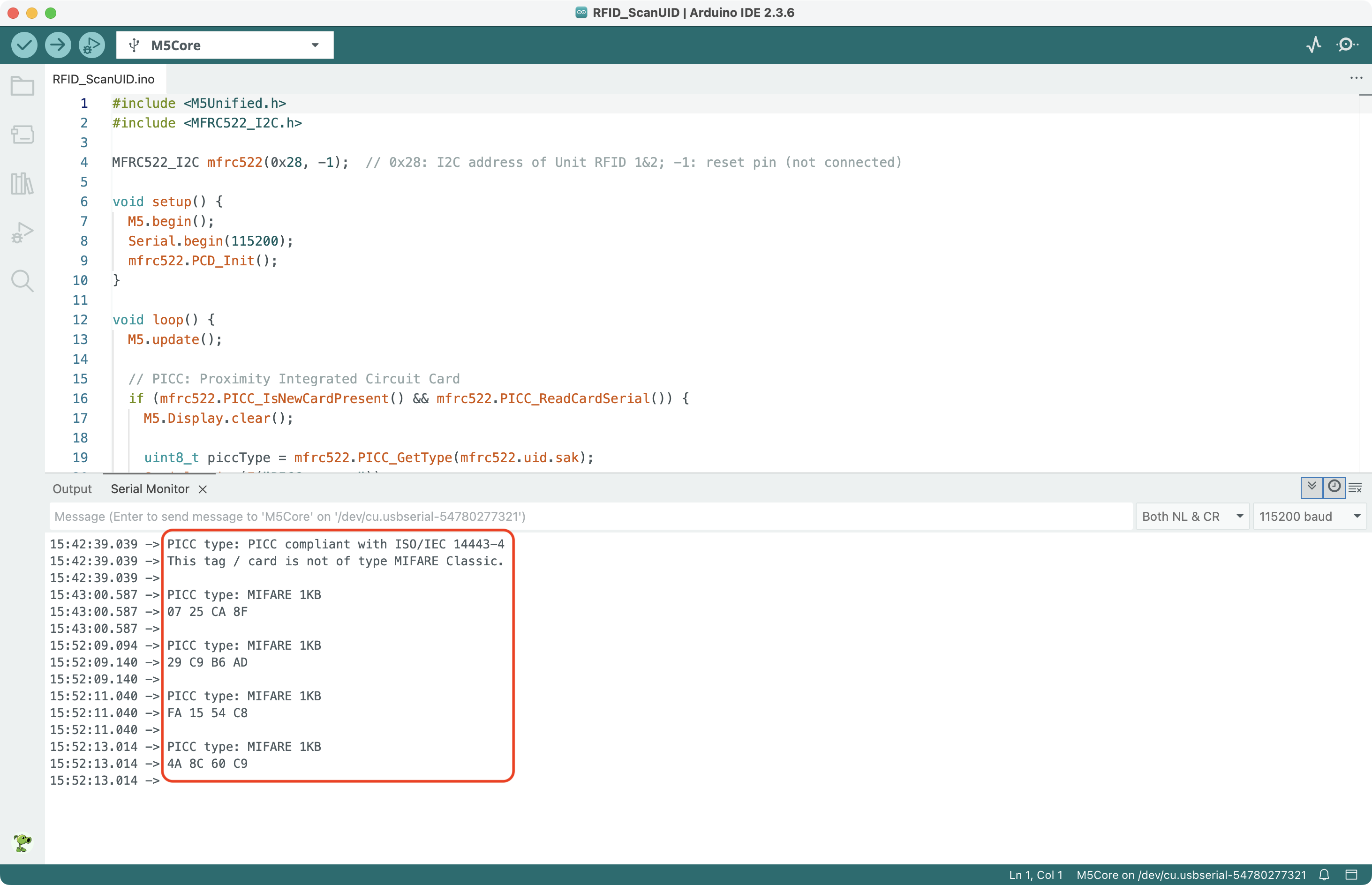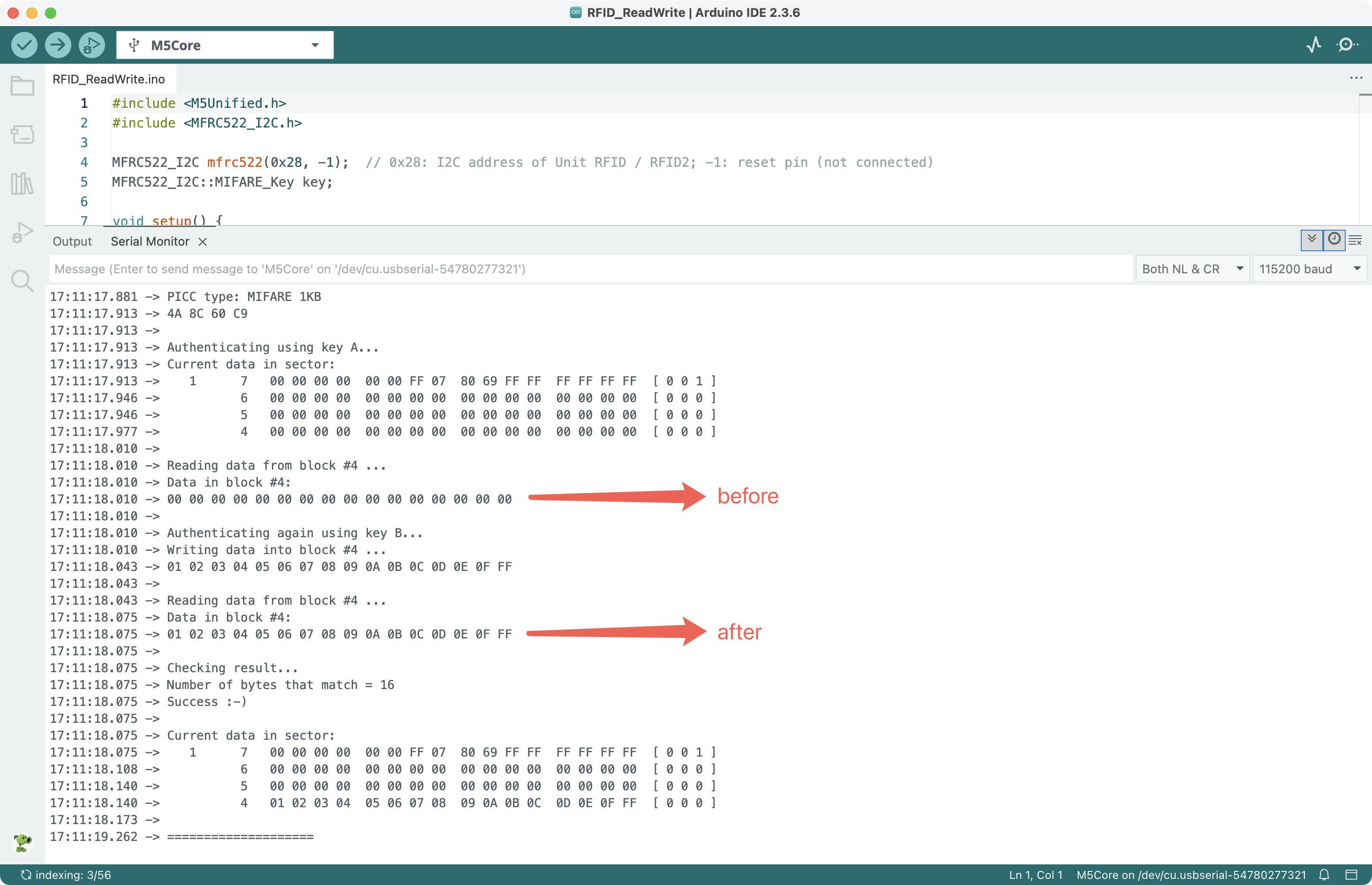Unit RFID / RFID2 Arduino 使用教程
1.准备工作
- 环境配置:参考 Arduino IDE 上手教程 完成 IDE 安装,并根据实际使用的开发板安装对应的板管理与需要的驱动库。
- 使用到的驱动库:
- 使用到的硬件产品:
- Basic v2.7
- Unit RFID2 或 Unit RFID


2.读取UID示例
编译要求
M5Stack 板管理版本 >= 3.2.2
M5Unified 库版本 >= 0.2.8
M5GFX 库版本 >= 0.2.11
MFRC522_I2C 库版本 >= 1.0
M5Unified 库版本 >= 0.2.8
M5GFX 库版本 >= 0.2.11
MFRC522_I2C 库版本 >= 1.0
cpp
1 2 3 4 5 6 7 8 9 10 11 12 13 14 15 16 17 18 19 20 21 22 23 24 25 26 27 28 29 30 31 32 33 34 35 36 37 38 39
#include <M5Unified.h>
#include <MFRC522_I2C.h>
MFRC522_I2C mfrc522(0x28, -1); // 0x28: I2C address of Unit RFID / RFID2; -1: reset pin (not connected)
void setup() {
M5.begin();
Serial.begin(115200);
mfrc522.PCD_Init();
}
void loop() {
M5.update();
// PICC: Proximity Integrated Circuit Card
if (mfrc522.PICC_IsNewCardPresent() && mfrc522.PICC_ReadCardSerial()) {
M5.Display.clear();
uint8_t piccType = mfrc522.PICC_GetType(mfrc522.uid.sak);
Serial.print(F("PICC type: "));
Serial.println(mfrc522.PICC_GetTypeName(piccType));
// Check if the tag / card is of type MIFARE Classic
if (piccType != MFRC522_I2C::PICC_TYPE_MIFARE_MINI
&& piccType != MFRC522_I2C::PICC_TYPE_MIFARE_1K
&& piccType != MFRC522_I2C::PICC_TYPE_MIFARE_4K) {
Serial.println(F("This tag / card is not of type MIFARE Classic.\n"));
delay(500);
return;
}
// Output the stored UID data
for (byte i = 0; i < mfrc522.uid.size; i++) {
Serial.printf("%02X ", mfrc522.uid.uidByte[i]);
}
Serial.println("\n");
delay(500);
}
}
3.读写卡示例
编译要求
M5Stack 板管理版本 >= 3.2.2
M5Unified 库版本 >= 0.2.8
M5GFX 库版本 >= 0.2.11
MFRC522_I2C 库版本 >= 1.0
M5Unified 库版本 >= 0.2.8
M5GFX 库版本 >= 0.2.11
MFRC522_I2C 库版本 >= 1.0
cpp
1 2 3 4 5 6 7 8 9 10 11 12 13 14 15 16 17 18 19 20 21 22 23 24 25 26 27 28 29 30 31 32 33 34 35 36 37 38 39 40 41 42 43 44 45 46 47 48 49 50 51 52 53 54 55 56 57 58 59 60 61 62 63 64 65 66 67 68 69 70 71 72 73 74 75 76 77 78 79 80 81 82 83 84 85 86 87 88 89 90 91 92 93 94 95 96 97 98 99 100 101 102 103 104 105 106 107 108 109 110 111 112 113 114 115 116 117 118 119 120 121 122 123 124 125 126 127 128 129 130 131 132 133 134 135 136 137 138 139 140 141 142 143 144 145 146 147 148 149 150 151 152 153 154 155 156 157 158 159 160 161 162 163 164 165 166 167 168
#include <M5Unified.h>
#include <MFRC522_I2C.h>
MFRC522_I2C mfrc522(0x28, -1); // 0x28: I2C address of Unit RFID / RFID2; -1: reset pin (not connected)
MFRC522_I2C::MIFARE_Key key;
void setup() {
M5.begin();
Serial.begin(115200);
mfrc522.PCD_Init();
// Prepare the key (used both as key A and as key B) with FFFFFFFFFFFFh,
// which is the default at chip delivery from the factory.
for (byte i = 0; i < 6; i++) {
key.keyByte[i] = 0xFF;
}
}
// Helper routine to dump a byte array as hex values to Serial.
void dump_byte_array(byte *buffer, byte bufferSize) {
for (byte i = 0; i < bufferSize; i++) {
Serial.printf("%02X ", buffer[i]);
}
}
void loop() {
M5.update();
// PICC: Proximity Integrated Circuit Card
if (mfrc522.PICC_IsNewCardPresent() && mfrc522.PICC_ReadCardSerial()) {
M5.Display.clear();
uint8_t piccType = mfrc522.PICC_GetType(mfrc522.uid.sak);
Serial.print(F("PICC type: "));
Serial.println(mfrc522.PICC_GetTypeName(piccType));
// Check if the tag / card is of type MIFARE Classic
if (piccType != MFRC522_I2C::PICC_TYPE_MIFARE_MINI
&& piccType != MFRC522_I2C::PICC_TYPE_MIFARE_1K
&& piccType != MFRC522_I2C::PICC_TYPE_MIFARE_4K) {
Serial.println(F("This tag / card is not of type MIFARE Classic.\n"));
delay(500);
return;
}
// Output the stored UID data
String uid = "";
for (byte i = 0; i < mfrc522.uid.size; i++) {
Serial.printf("%02X ", mfrc522.uid.uidByte[i]);
uid += String(mfrc522.uid.uidByte[i], HEX);
}
Serial.println("\n");
// mfrc522.PICC_DumpToSerial(&(mfrc522.uid));
// Serial.println("\n");
// In this example, we use the second sector (sector #1) including blocks #4, #5, #6, #7
byte sector = 1;
byte blockAddr = 4;
byte trailerBlock = 7;
byte dataBlock[] = {
0x01, 0x02, 0x03, 0x04, // 1, 2, 3, 4,
0x05, 0x06, 0x07, 0x08, // 5, 6, 7, 8,
0x09, 0x0a, 0x0b, 0x0c, // 9, 10, 11, 12,
0x0d, 0x0e, 0x0f, 0xff // 13, 14, 15, 255
};
MFRC522_I2C::StatusCode status;
byte buffer[18];
byte size = sizeof(buffer);
// Authenticate using key A
Serial.println(F("Authenticating using key A..."));
status = (MFRC522_I2C::StatusCode)mfrc522.PCD_Authenticate(MFRC522_I2C::PICC_CMD_MF_AUTH_KEY_A, trailerBlock, &key, &(mfrc522.uid));
if (status != MFRC522_I2C::STATUS_OK) {
Serial.print(F("PCD_Authenticate() failed: "));
Serial.println(mfrc522.GetStatusCodeName(status));
return;
}
// Show the whole sector as it currently is
Serial.println(F("Current data in sector: "));
mfrc522.PICC_DumpMifareClassicSectorToSerial(&(mfrc522.uid), &key, sector);
Serial.println("");
// Read data from the block
Serial.print(F("Reading data from block #"));
Serial.print(blockAddr);
Serial.println(F(" ..."));
status = (MFRC522_I2C::StatusCode)mfrc522.MIFARE_Read(blockAddr, buffer, &size);
if (status != MFRC522_I2C::STATUS_OK) {
Serial.print(F("MIFARE_Read() failed: "));
Serial.println(mfrc522.GetStatusCodeName(status));
}
Serial.print(F("Data in block #"));
Serial.print(blockAddr);
Serial.println(F(": "));
dump_byte_array(buffer, 16);
Serial.println("\n");
// Authenticate using key B
Serial.println(F("Authenticating again using key B..."));
status = (MFRC522_I2C::StatusCode)mfrc522.PCD_Authenticate(MFRC522_I2C::PICC_CMD_MF_AUTH_KEY_B, trailerBlock, &key, &(mfrc522.uid));
if (status != MFRC522_I2C::STATUS_OK) {
Serial.print(F("PCD_Authenticate() failed: "));
Serial.println(mfrc522.GetStatusCodeName(status));
return;
}
// Write data to the block
Serial.print(F("Writing data into block #"));
Serial.print(blockAddr);
Serial.println(F(" ..."));
dump_byte_array(dataBlock, 16);
Serial.println();
status = (MFRC522_I2C::StatusCode)mfrc522.MIFARE_Write(blockAddr, dataBlock, 16);
if (status != MFRC522_I2C::STATUS_OK) {
Serial.print(F("MIFARE_Write() failed: "));
Serial.println(mfrc522.GetStatusCodeName(status));
}
Serial.println("");
// Read data from the block again, now it should be what we have written
Serial.print(F("Reading data from block #"));
Serial.print(blockAddr);
Serial.println(F(" ..."));
status = (MFRC522_I2C::StatusCode)mfrc522.MIFARE_Read(blockAddr, buffer, &size);
if (status != MFRC522_I2C::STATUS_OK) {
Serial.print(F("MIFARE_Read() failed: "));
Serial.println(mfrc522.GetStatusCodeName(status));
}
Serial.print(F("Data in block #"));
Serial.print(blockAddr);
Serial.println(F(": "));
dump_byte_array(buffer, 16);
Serial.println("\n");
// Check if the data in block is what we have written, by counting the number of bytes that are equal
Serial.println(F("Checking result..."));
byte count = 0;
for (byte i = 0; i < 16; i++) {
// Compare buffer (what we've read) with dataBlock (what we've written)
if (buffer[i] == dataBlock[i]) {
count++;
}
}
Serial.print(F("Number of bytes that match = "));
Serial.println(count);
if (count == 16) {
Serial.println(F("Success :-)"));
} else {
Serial.println(F("Failure, no match :-("));
Serial.println(F(" perhaps the write didn't work properly..."));
}
Serial.println();
// Dump the sector data
Serial.println(F("Current data in sector: "));
mfrc522.PICC_DumpMifareClassicSectorToSerial(&(mfrc522.uid), &key, sector);
Serial.println("");
// Halt PICC
mfrc522.PICC_HaltA();
// Stop encryption on PCD
mfrc522.PCD_StopCrypto1();
Serial.println("====================");
}
}这段程序会在完成 Key A 认证后读取 Sector 1 中的 Block 4 的数据,然后在完成 Key B 认证后修改 Sector 1 中的 Block 4 的数据。在这个过程中标签 / 卡片需要保持靠近 Unit RFID2。程序输出如下:

4.Init API
以下为常用 API 的使用说明。一般读写 MIFARE 卡的流程为:
- 初始化 RFID
- 检测新卡存在,获取卡 UID
- 通过 UID 选中卡片,进入 active 状态
- 通过 Key A、Key B 解锁对应的 Block
- 读 / 写数据
- 控制卡进入休眠状态
操作返回值状态码
cpp
1 2 3 4 5 6 7 8 9 10 11
enum StatusCode {
STATUS_OK = 1, // Success
STATUS_ERROR = 2, // Error in communication
STATUS_COLLISION = 3, // Collision detected
STATUS_TIMEOUT = 4, // Timeout in communication
STATUS_NO_ROOM = 5, // The buffer is not big enough
STATUS_INTERNAL_ERROR = 6, // Internal error in the code. Should not happen ;-)
STATUS_INVALID = 7, // Invalid argument
STATUS_CRC_WRONG = 8, // The CRC_A does not match
STATUS_MIFARE_NACK = 9 // The MIFARE PICC responded with NAK
};实例化
函数原型:
MFRC522_I2C(byte chipAddress, byte resetPowerDownPin);功能说明:
- 创建一个 RFID 实例
传入参数:
- byte chipAddress
- 模块的 I2C 地址(0x28)
- byte resetPowerDownPin
- 主控连接到模块的复位引脚,由于未连接所以设置为 -1
返回值:
- MFRC522_I2C 类的对象
PCD_Init
函数原型:
void PCD_Init();功能说明:
- 初始化读写器
传入参数:
- null
返回值:
- null
PICC_IsNewCardPresent
函数原型:
bool PICC_IsNewCardPresent();功能说明:
- 扫描是否存在未检测过且处于
IDLE状态的卡片,处于HALT状态的卡片将被忽略。
传入参数:
- null
返回值:
- bool
- true: 扫描到了新卡
- false: 未扫描到新卡
PICC_ReadCardSerial
函数原型:
bool PICC_ReadCardSerial();功能说明:
- 读取卡 UID,读取成功后的 UID 可以在类成员
Uid uid;中读取。读取操作前需执行PICC_IsNewCardPresent()或PICC_RequestA()或PICC_WakeupA()确保读取到卡片。
cpp
1 2 3
for (byte i = 0; i < mfrc522.uid.size; i++) {
Serial.printf("%02X ", mfrc522.uid.uidByte[i]);
}传入参数:
- null
返回值:
- bool
- true: 读取成功
- false: 读取失败
PICC_RequestA
函数原型:
uint8_t PICC_RequestA(uint8_t *bufferATQA, uint8_t *bufferSize);功能说明:
- 扫描检测读取范围内的 Type A 标准的卡片
传入参数:
- uint8_t *bufferATQA
- 存储请求响应 ATQA (Answer to request) 的 buffer
- uint8_t *bufferSize
- buffer 长度 (>2 byte)
返回值:
- uint8_t
- StatusCode
PICC_WakeupA
函数原型:
uint8_t PICC_WakeupA(uint8_t *bufferATQA, uint8_t *bufferSize);功能说明:
- 唤醒范围内的 Type A 标准的卡片
传入参数:
- uint8_t *bufferATQA
- 存储请求响应 ATQA (Answer to request) 的 buffer
- uint8_t *bufferSize
- buffer 长度 (>2 byte)
返回值:
- uint8_t
- StatusCode
PICC_Select
函数原型:
uint8_t PICC_Select(Uid *uid, uint8_t validBits = 0);功能说明:
- 通过 uid 选中一张卡片进入 active 状态
传入参数:
- Uid *uid
- 通过扫描获取到的卡片 uid 结构体指针
- uint8_t validBits
- 最后一个 uint8_t 中的有效位,0 表示 8 个有效位
返回值:
- uint8_t
- StatusCode
PICC_HaltA
函数原型:
uint8_t PICC_HaltA();功能说明:
- 选中当前卡片进入休眠状态
传入参数:
- null
返回值:
- uint8_t
- StatusCode
5.MIFARE API
PCD_Authenticate
函数原型:
uint8_t PCD_Authenticate(uint8_t command, uint8_t blockAddr, MIFARE_Key *key, Uid *uid);功能说明:
- 进行 MIFARE 身份验证。在调用此函数之前,需要对卡片进行 select 操作使其处于 active 状态。经过身份验证的 PICC 通信结束后需调用
PCD_StopCrypto1(),否则无法开始新的通信。
传入参数:
- uint8_t command
- PICC_CMD_MF_AUTH_KEY_A
- PICC_CMD_MF_AUTH_KEY_B
- uint8_t blockAddr
- Block 地址
- MIFARE_Key *key
- 默认状态下,Key A、Key B 均为
FFFFFFFFFFFF
- 默认状态下,Key A、Key B 均为
- Uid *uid
返回值:
- uint8_t
- StatusCode
PCD_StopCrypto1
函数原型:
void PCD_StopCrypto1();功能说明:
- 退出 PCD 的认证状态。经过身份验证的 PICC 通信结束后需调用
PCD_StopCrypto1(),否则无法开始新的通信。
传入参数:
- null
返回值:
- null
MIFARE_Read
函数原型:
uint8_t MIFARE_Read(uint8_t blockAddr, uint8_t *buffer, uint8_t *bufferSize);功能说明:
- 从指定 blockAddr 读取数据
传入参数:
- uint8_t blockAddr
- 实际卡片扇区中的 block 地址
- uint8_t *buffer
- 接收数据的 buffer 指针
- uint8_t *bufferSize
- 接收数据的 buffer 长度 (>=18 byte)
返回值:
- uint8_t
- StatusCode
MIFARE_Write
函数原型:
uint8_t MIFARE_Write(uint8_t blockAddr, uint8_t *buffer, uint8_t bufferSize);功能说明:
- 向指定 blockAddr 写入数据
传入参数:
- uint8_t blockAddr
- 实际卡片扇区中的 block 地址
- uint8_t *buffer
- 写入数据的 buffer 指针
- uint8_t *bufferSize
- 写入数据的 buffer 长度 (16 byte)
返回值:
- uint8_t
- StatusCode
6.参考链接
- 更多相关的 API 可以参考 MFRC522_I2C 库
- ISO/IEC 14443 - Wikipedia
- MFRC522 - NXP Docs (Standard performance MIFARE and NTAG frontend)
- MFRC523 - NXP Docs (Standard performance ISO/IEC 14443 A/B frontend)
- MIFARE Classic EV1 1K - NXP Docs (中文版)
- MIFARE Classic EV1 4K - NXP Docs
- AN1305 - NXP Docs (MIFARE Classic as NFC Type MIFARE Classic Tag)
- AN10833 - NXP Docs (MIFARE type identification procedure)
- AN10834 - NXP Docs (MIFARE ISO/IEC 14443 PICC selection)
